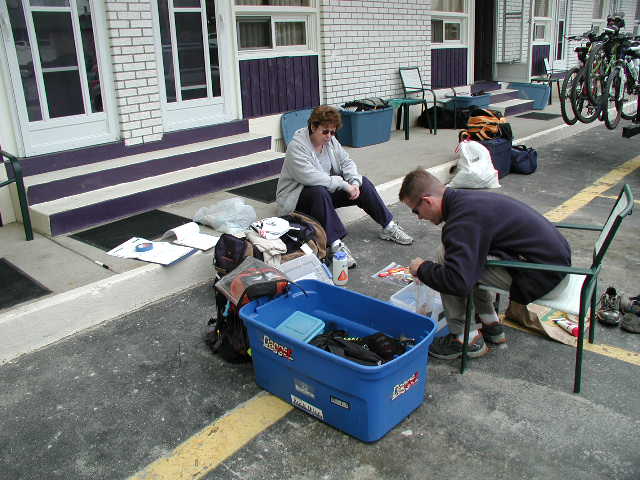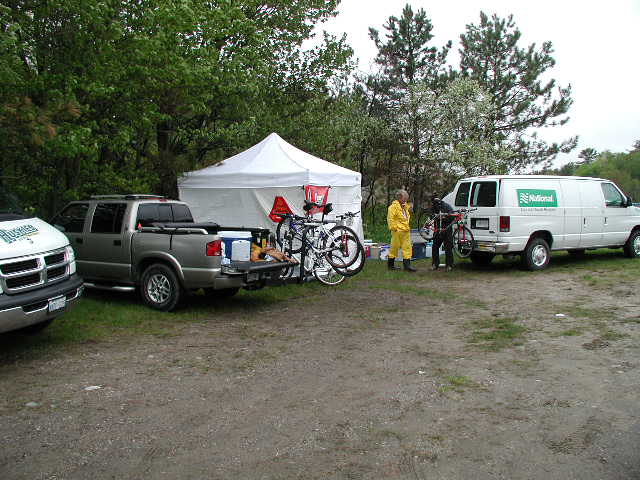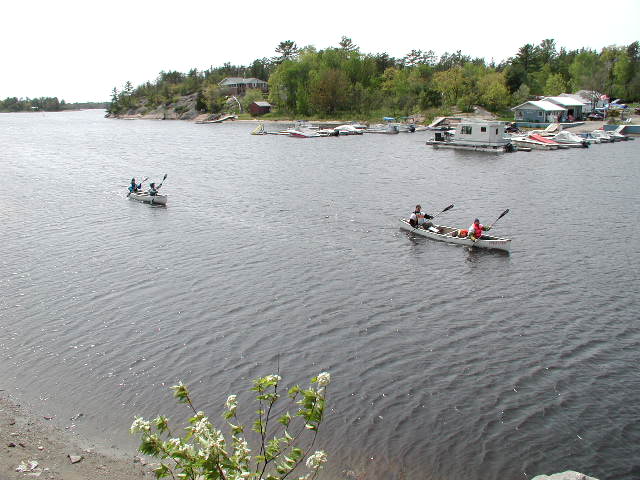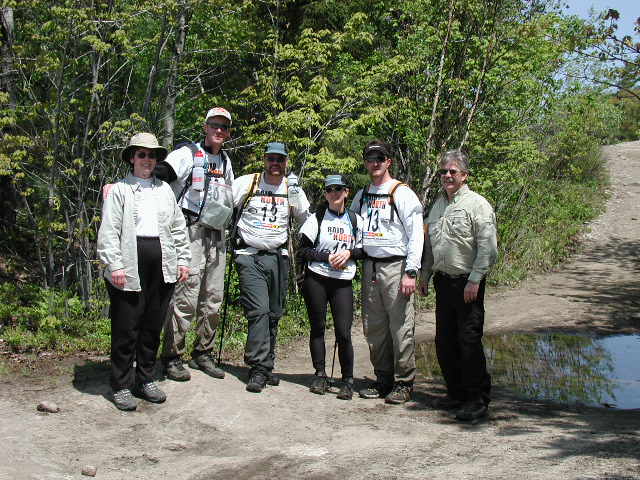|
This story is written
from the perspective of the support crew at this year’s
RtN in Parry Sound, Ontario.
We spent many years supporting our son, TOT team captain,
John, during his BMX racing career and into mountain
biking. So when the call came asking if we would be
the support crew for this year’s RtN of course
we agreed. We knew John’s teammate Randy but had
not met Annie or Steve. John and Randy have been racing
together for some time. They have raced with Annie and
Annie has raced with Steve, but this will be the first
time the four have raced as a team. We have high hopes
for this combination.
While
the team was getting their bodies and spirits in shape
for this undertaking we were planning how to get their
equipment from place to place. We made trips to several
stores looking for the perfect cartop carrier. Last
year we had a van and this year we have a pickup with
a crewcab so we were looking for some extra carrying
space over the bed of the truck. We found what we thought
would work for us. Individual team member tubs should
fit inside the bed, our equipment should fit in the
carrier on top of the bed cover, 4 bikes on the hitch
mounted bike rack and our personal stuff in the backseat
of the cab.
Keith
picked up a canopy with 4 sides this year. RtN was cold
and windy last year. We were determined to be prepared
in case this year was a repeat. We found a good spot
to put the canopy on the back of the truck and bungee
corded our chairs to the roof of the cab. We packed
our mandatory gear including our tent and then packed
everything we thought we would need to make the team
comfortable during transitions. Most of the items in
the cartop carrier were for use in the transition area.
A campstove, food, lighting in case the transitions
were in the dark, plates, cups, spoons, saucepan, thermoses
for keeping soup hot and a small heater for inside the
canopy.
The plan was coming together. TOT will arrive at our
house on Thursday in two vehicles. They will drop off
one vehicle, transfer equipment to our truck and we
will go on to Parry Sound. They will be up early on
Friday to check in. During the afternoon we will go
over equipment with each racer so we know what they
expect during the transitions. We then have a pre-race
meeting at 4:00. After the meeting Keith and I will
pack the truck and let the team get some rest before
the start at midnight. Sounded smooth until the team
arrived at the house. Oh, oh, some of the tubs were
too tall to fit under the pickup bed cover. A little
rearranging is necessary. We have some shorter tubs
in our garage so we empty the tall tubs and repack into
the shorter ones. Problem solved.
 We
had an uneventful drive up to Parry Sound. Because of
the threat of West Nile, SARS and Mad Cow Disease we
held our breath going through Toronto. The scenery was
beautiful and wilder the further we went north. Signs
said the Georgian Bay has 30,000 islands and I believe
it. Some islands were so small a house took up the entire
island. Parry Sound itself was a small town and seemed
dedicated to recreation and adventure. Unfortunately,
when Steve picked up a local paper the headline read,
SARS IN PARRY SOUND. Oh well, we’ll be out in the
wilderness; SARS won’t have a chance out there. We
had an uneventful drive up to Parry Sound. Because of
the threat of West Nile, SARS and Mad Cow Disease we
held our breath going through Toronto. The scenery was
beautiful and wilder the further we went north. Signs
said the Georgian Bay has 30,000 islands and I believe
it. Some islands were so small a house took up the entire
island. Parry Sound itself was a small town and seemed
dedicated to recreation and adventure. Unfortunately,
when Steve picked up a local paper the headline read,
SARS IN PARRY SOUND. Oh well, we’ll be out in the
wilderness; SARS won’t have a chance out there.
Friday
morning registration went smooth thanks to the efficiency
of the RtN staff. The team was excited to be here and
the weather looked beautiful so far. We returned to
the motel for equipment checks and last minute changes
in transition plans. Before the race there had been
a lively debate about whether to switch packs at transition
and whether to change to bike shoes or just use one
pair of shoes. In the end they all decided to go with
one pack but the shoe debate continued. Each team member
arranged their equipment and labeled what they wanted
for each discipline. They also put together packages
of food and goodies they wanted to take at the transition
areas. The parking lot was full of equipment for our
team and others at the motel. The TOT and Dagger banners
were on prominent display.
Luckily,
we had an unofficial but essential member of the support
crew. Some of the team HAD to be back in Illinois Monday
AM, so Annie brought her friend Vicki along as an extra
driver for the trip home. Vicki was a lifesaver more
than once. While we went over equipment she ran out
to the local bike shop and picked up some items for
the team and helped set up bladders for the transition
area. We also needed some more food.
The
4:00 meeting finally came and the team got their maps
and instructions. Now the excitement would start. The
team went back to the hotel and plotted their way across
the wilderness and then got some rest while we squeezed
the equipment back into the truck and picked up pizza
for everyone. We were allowed a second support
vehicle to get to the start line so Vicki agreed to
drive the team. We gave her a copy of the driving instructions
for the support team so she could meet us at the transition
area on Saturday morning and see the team on their way
through. We left for the start line around 11PM with
spirits running high. They will start on bikes but there
was a slight problem with Annie’s bike after we
unloaded it. After some adjusting the team continued
to move to the start line.
At
midnight they were off. We were told that we would be
allowed to go the bike pickup in about two hours after
all the riders went through. We were also told that
they would not be as strict this year and we would be
allowed to go into town, stop off and have a shower
etc. if we wanted. We just had to let race staff know
where we were. This was a real plus. Vicki kept the
motel room in town so we took advantage of the rules
and went back to the room to get some paperwork we forgot.
We went back to the start area and waited for the release
to pick up the bikes. We were told that we would be
released about 2 or 2:30 AM. But time marched on and
about 4:00 people started getting antsy. We were finally
let go at 4:30. No sleep because we expected to be released
any minute.
We
picked our way through the back roads in the dark and
found the bike drop off. Since it was still dark we
had difficulty finding our team bikes. But finally,
success, they were up near the front. This is a good
sign! We were told at the support meeting that the first
teams would not be expected before 8:00 so we didn’t
hurry to the first transition area. May as well set
up in the daylight.
 The
first transition area was in a provincial park. Support
crews set up near the canoe takeout area. The park also
had a big plus. Flush toilets were only a 60 second
walk away in the campground right behind us. Also there
was a hose for cleaning off bikes in the maintenance
yard. We got our canopy set up and unpacked what we
needed from the truck. It was pretty chilly and windy
so we used all 4 sides of the canopy. The Velcro ties
kept letting go so we had to improvise by using clamps
to hold the corners together. We fired up the heater
and tried to dry out bike shoes and chairs. We were
too excited to sleep or eat. We knew we would see the
team soon. The
first transition area was in a provincial park. Support
crews set up near the canoe takeout area. The park also
had a big plus. Flush toilets were only a 60 second
walk away in the campground right behind us. Also there
was a hose for cleaning off bikes in the maintenance
yard. We got our canopy set up and unpacked what we
needed from the truck. It was pretty chilly and windy
so we used all 4 sides of the canopy. The Velcro ties
kept letting go so we had to improvise by using clamps
to hold the corners together. We fired up the heater
and tried to dry out bike shoes and chairs. We were
too excited to sleep or eat. We knew we would see the
team soon.
The
teams would be coming in off a long paddling section.
TOT had rented some fancy schmancy carbon fiber paddles
that came in 5 pieces and were incredibly light in their
packs. Hopefully the price of the rental would be worth
it. At 7:57 we saw the lead team come into the transition
area. Now the support teams were getting excited but
the weather had turned. It was very windy with a misty
rain. The lead team was tired and was still in the transition
area 45 minutes later when the next team arrived. Race
staff was very helpful and communication was excellent
but that didn’t erase the fact that 39 teams were
still out there in terrible conditions with 3-foot swells,
whitecaps and a fierce headwind. Our team was one of
the few that had left checkpoint 4 and was headed to
checkpoint 5, TA 1 was also checkpoint 6. We heard of
several teams capsizing and the rescue boats were busy.
8 teams were stuck on an island waiting for rescue but
our team was still forging on. The support crew next
to us heard from their team. They were taken in by a
family and were enjoying some warm beverages at their
home. As teams were rescued, the race staff came through
the camp looking for their support crew to pick them
up and transport them to the transition area. Meanwhile
Keith cleaned up the bikes and made adjustments because
they will be back on a bike section when they leave
the transition area. Vicki arrived to wait with us.
It was a real nail biter for the support crews. We heard
stories about the rescue boats reluctance to go out
because of the poor conditions on the water but our
team was still out there.
 Finally
we heard that they had cleared checkpoint 5 so we started
to get ready for them. They would be cold and wet so
we heated up the soup and readied the gear. The transition
camp was a buzz of activity by then. There was a hill
where support crews watched the final stretch of paddling.
The weather turned sunny but it was still very windy.
We were ready and anxious. The camaraderie of the support
crews was great. Each time someone could see canoes
coming there was a lot of hollering between support
crews about who was coming. Before long we were the
lucky crew. We had binoculars but their team number
wasn’t visible. Annie had gotten cold and wore
her space blanket under her life jacket. Others had
put on more clothes. But we finally recognized their
smiles when they saw the canoe takeout. Finally
we heard that they had cleared checkpoint 5 so we started
to get ready for them. They would be cold and wet so
we heated up the soup and readied the gear. The transition
camp was a buzz of activity by then. There was a hill
where support crews watched the final stretch of paddling.
The weather turned sunny but it was still very windy.
We were ready and anxious. The camaraderie of the support
crews was great. Each time someone could see canoes
coming there was a lot of hollering between support
crews about who was coming. Before long we were the
lucky crew. We had binoculars but their team number
wasn’t visible. Annie had gotten cold and wore
her space blanket under her life jacket. Others had
put on more clothes. But we finally recognized their
smiles when they saw the canoe takeout.
They
were tired and had sore arms from paddling but we got
some soup in them and restocked their packs. The crew
next to us shared some of their hot food as well. We
were extremely proud of our team. They made it through
the roughest paddling section where most other teams
gave up or were plucked from the bay. This became a
source of pride around the campfire at the second transition
area. We were able to say that our team was between
checkpoint 7 and 8 AND had finished the paddling section.
That gave us a certain status among support crews.
We
left TA 1 and picked up the bikes at CP 7. An easy drive
where we discovered that the road to TA 2 took us back
almost all the way to Parry Sound. We decided to take
advantage of the relaxed rules again and stopped to
visit Vicki and have a shower and a muffin at Tim Horton’s.
 The
second transition area, checkpoint 9, was located down
the worst road we had ever driven. Keith was glad we
had four wheel drive because there were several spots
where we encountered large mudholes loaded with rocks.
We were also glad that we were able to negotiate it
during daylight. One area was actually lower than the
lake surrounding us. This TA did not have the amenities
that the first TA had but it was situated on an idyllic
lakeshore and at night the stars shown brightly against
the inky black sky. By the time we were set up it was
midnight and we were told that the fastest they would
make it from checkpoint 8 was 2 hours. The earliest
we expected to see them was 2 AM. So we set our alarm
for 2 hours to get some sleep. Keith was confident and
didn’t want to set up the tent so we slept in the
cab of the truck. We checked in with the race staff
at 2-hour intervals until daylight. The team would probably
not meet the cutoff to go on so we were concerned about
how we would get them and their equipment out of the
TA. Keith asked if we would be expected to pick them
up at checkpoint 8 and he learned that would be impossible.
Checkpoint 8 was so remote that vehicles could not get
in and the CP 8 staff had to hike in. We found out later
that our team had hunkered down for a few hours during
the darkest of the night so they wouldn’t stumble
over a 49 ft. cliff. We finally got word from the TA
staff that our team had passed checkpoint 8. They asked
race staff to relay a message to us that they were fine
and moving on. The
second transition area, checkpoint 9, was located down
the worst road we had ever driven. Keith was glad we
had four wheel drive because there were several spots
where we encountered large mudholes loaded with rocks.
We were also glad that we were able to negotiate it
during daylight. One area was actually lower than the
lake surrounding us. This TA did not have the amenities
that the first TA had but it was situated on an idyllic
lakeshore and at night the stars shown brightly against
the inky black sky. By the time we were set up it was
midnight and we were told that the fastest they would
make it from checkpoint 8 was 2 hours. The earliest
we expected to see them was 2 AM. So we set our alarm
for 2 hours to get some sleep. Keith was confident and
didn’t want to set up the tent so we slept in the
cab of the truck. We checked in with the race staff
at 2-hour intervals until daylight. The team would probably
not meet the cutoff to go on so we were concerned about
how we would get them and their equipment out of the
TA. Keith asked if we would be expected to pick them
up at checkpoint 8 and he learned that would be impossible.
Checkpoint 8 was so remote that vehicles could not get
in and the CP 8 staff had to hike in. We found out later
that our team had hunkered down for a few hours during
the darkest of the night so they wouldn’t stumble
over a 49 ft. cliff. We finally got word from the TA
staff that our team had passed checkpoint 8. They asked
race staff to relay a message to us that they were fine
and moving on.
 Hooray!
They’re coming but still how will we get them out?
We combined as much as we could to conserve space. Some
of the tubs had some airspace in them; surely we can
get more stuff in there so we can empty the back seat.
We started to plan how we were going to stack things
on the truck. We were at the point of planning what
to put in the back seat that was flat so the men could
sit 3 across with Annie lying on top when Vicki came
to the rescue again. She arrived about an hour before
the team came into the TA. Not only was she a lifesaver,
she also brought Egg McMuffins! Hooray!
They’re coming but still how will we get them out?
We combined as much as we could to conserve space. Some
of the tubs had some airspace in them; surely we can
get more stuff in there so we can empty the back seat.
We started to plan how we were going to stack things
on the truck. We were at the point of planning what
to put in the back seat that was flat so the men could
sit 3 across with Annie lying on top when Vicki came
to the rescue again. She arrived about an hour before
the team came into the TA. Not only was she a lifesaver,
she also brought Egg McMuffins!
We
started walking down the trail to greet our team coming
in and saw another team. We asked if they saw team #13
and they said they saw a team they thought was American.
It had to be them! Five minutes later we saw them.
They
made it a full 36 hours, never gave up. They may not
cross the finish line but hopefully they are as proud
of their accomplishment as their support crew. When
asked later about whether he intended to do it again
next year, John did not hesitate. Of course he’ll
be back; he has to finish it.
|